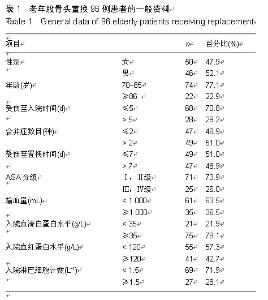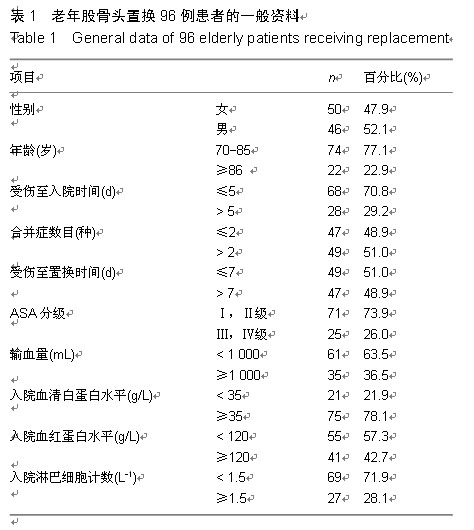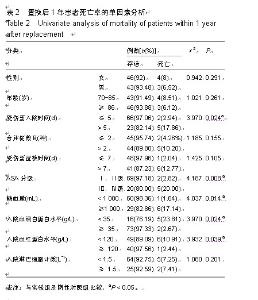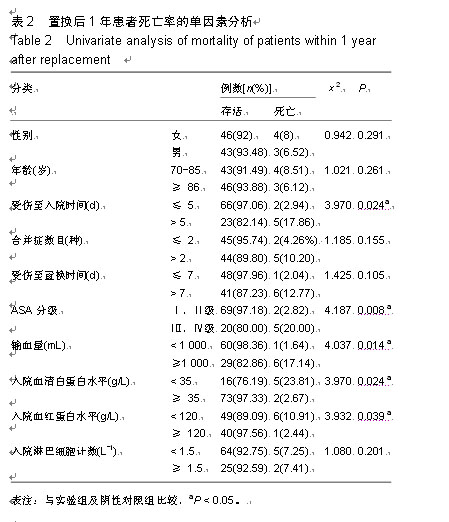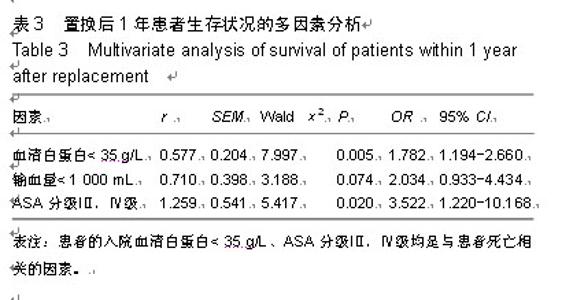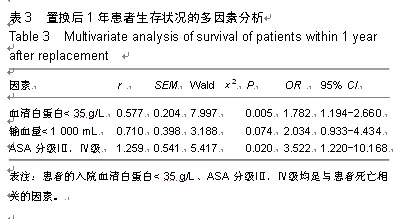| [1] 熊健斌,宏志,彭伟球.人工股骨头置换用于老年转子部不稳定骨折的临床分析[J].中国老年学杂志,2011,31(17):3393-3394.
[2] 王志明,王磊,胡其恭,等.股骨头置换与内固定治疗不稳定型老年转子间骨折的远期疗效对比[J].中国医师杂志,2014,16(3): 407-409.
[3] 陈琪,潘海燕,郭薇.股骨头置换患者出院前负性情绪及危险因素研究[J].安徽医药,2014,18(6):1184-1186.
[4] Osmonbekova NS, Popovich VK, Chinikov MA, et al. The quality of life after cholecystectomy. Khirurgiia (Mosk). 2013; 1(8):24-28.
[5] 宋海平,林秋炜,陈玉芳.股骨头置换对患者生活质量的影响及影响因素分析[J].中国医疗前沿,2013,18(8):119-120.
[6] 邓丰承,胡锐明,邹伟民,等.股骨头置换对高龄股骨转子间骨折患者置换置换后生存质量的影响[J].中国医药导报,2013,10(10): 55-57.
[7] 王莉,侯锐,胡开进.ASA分级系统在口腔外科门诊治疗中的应用[J].实用口腔医学杂志,2012,28(1):51-54.
[8] 王振恒,方永超,阚翔翔,等.影响老年髋部骨折患者置换后 1 年死亡率的因素分析[J].中国矫形外科杂志,2014,22(2):110-114.
[9] Vochteloo AJH, van der Burg BLSB, Mertens BJA, et al. Outcome in hip fracture patients related to anemia at admission and allogeneic blood transfusion: an analysis of 1262 surgically treated patients. BMC Musculoskel Disord. 2011;12(1):262.
[10] 肖百香.个性化舒适护理在老年股骨头置换围术期中的应用[J].齐鲁护理杂志,2012,18(9):36-37.
[11] Panula J, Pihlajamaki H, Mattila VM, et al. Mortality and cause of death in hip fracture patients aged 65 or older: a population-based study. BMC Musculoskel Disord. 2011;12(1): 105.
[12] 黄晓,莫冰峰,尹东,等.老年髋部骨折后死亡的相关影响因素分析[J].中国矫形外科杂志,2013,21(8):757-761.
[13] Ho HH, Lau TW, Leung F, et al. Peri-operative management of anti-platelet agents and anti-thrombotic agents in geriatric patients un-dergoing semiurgent hip fracture surgery. Osteoporos Int. 2010;4(1):573-577.
[14] 曹建国.微创PFNA内固定与人工股骨头置换术治疗高龄股骨转子间骨折的临床对比研究[J].中国医师进修杂志,2013,36(5): 56-57.
[15] 胡田生,胡方煜,蒋晓春.对30例高龄患者行人工股骨头置换术采用仰卧位外侧切口的临床观察[J].中国医药导报,2013,19(6): 47-48.
[16] 左进步,余磊,梁宏伟,等.人工股骨头置换术治疗高龄股骨转子间骨折中股距重建的策略[J].中国矫形外科杂志,2012,20(2): 186-188.
[17] 龚春柱.人工股骨头置换术治疗高龄患者不稳定性股骨转子间骨折[J].局解手术学杂志,2013,22(1):94-95.
[18] 张积森,徐又佳,刘虎,等.人工股骨头置换术治疗高龄股骨转子间骨折39例的疗效分析[J].颈腰痛杂志,2010,31(3):216-218.
[19] 周晓凯,易诚青,马春辉,等.人工双极股骨头置换术治疗百岁老人股骨颈骨折2例报道[J].上海交通大学学报,2012,32(12): 1564-1566.
[20] 庞军,王建伟.全髋关节置换术与人工双极股骨头置换术治疗高龄股骨颈骨折的疗效比较[J].中国医学前沿杂志,2014,6(6): 132-134.
[21] 张玉良,黄涛,尹尧,等.高龄患者股骨头置换术两种椎管内阻滞麻醉的效果观察[J].西南国防医药,2013,23(2):176-179.
[22] Parker SJ, Khan W, Mellor S. Late Nontraumatic Dissociation of the Femoral Head and Trunnion in a Total Hip Arthroplasty. Case Rep Orthop. 2015;2015:738671.
[23] Lin S, Zhang CQ, Jin DX. Combination of modified free vascularized fibular grafting and reverse Less Invasive Stabilization System (LISS) for the management of femoral neck nonunion in patients thirty years of age or younger. Injury. 2015.
[24] Ramalingam KK, Ramalingam R, Kalita K, et al. Our experience with femoro-femoral bypass in the management of critical airway problems. Indian J Otolaryngol Head Neck Surg. 2015;67(2):110-112.
[25] Klose-Jensen R, Hartlev LB, Thorup Boel LW, et al. Subchondral Bone Turnover, but not Bone Volume, is Increased in Early Stage Osteoarthritic Lesions in the Human Hip Joint. Osteoarthritis Cartilage. 2015.
[26] Alcobía Díaz B, Luque Pérez R, García Bullón I, et al. Long-term clinical and radiological outcomes in a serie of 26 cases of symptomatic adult developmental dysplasia of the hip managed with bernese periacetabular osteotomy. Rev Esp Cir Ortop Traumatol. 2015.
[27] Mont MA, Cherian JJ. CORR Insights: Frequent Femoral Neck Osteolysis With Birmingham Mid-head Resection Resurfacing Arthroplasty in Young Patients. Clin Orthop Relat Res. 2015.
[28] Wyles CC, Houdek MT, Crespo-Diaz RJ, et al. Adipose-derived Mesenchymal Stem Cells Are Phenotypically Superior for Regeneration in the Setting of Osteonecrosis of the Femoral Head. Clin Orthop Relat Res. 2015.
[29] Rajebi H, Rajebi MR. Optimizing Common Femoral Artery Access. Tech Vasc Interv Radiol. 2015;18(2):76-81.
[30] Millikan PD, Karas V, Wellman SS. Treatment of osteonecrosis of the femoral head with vascularized bone grafting. Curr Rev Musculoskelet Med. 2015.
[31] Yuan H. Comment on "Efficacy of Alendronate for Preventing Collapse of Femoral Head in Adult Patients with Nontraumatic Osteonecrosis". Biomed Res Int. 2015;2015:354109.
[32] 张景林,刘晓龙,杨树玲.高龄股骨转子间骨折人工股骨头置换的临床应用评价[J].山东医药,2014,54(17):70-72.
[33] 陈百康.两种不同麻醉方式在高龄患者股骨头置换术的临床研究[J].河北医学,2014,20(4):552-554.
[34] 吴元勇,郭金伟.人工关节置换术治疗高龄股骨粗隆间骨折42例分析[J].重庆医学,2013,42(11):1243-1244.
[35] 李自强.高龄股骨转子问骨折手术与非手术治疗的疗效比较[J].中国骨与关节损伤杂志,2006,21(6):463-464.
[36] 田仁元,叶鹏,邓江,等.髋关节置换后引流对患者康复影响的系统评价[J].中国组织工程研究,2013,17(35):6300-6305.
[37] 及宁,孙振辉,江泽华,等.髋关节置换和内固定修复老年股骨颈骨折再手术及并发症的系统分析[J].中国组织工程研究,2014, 18(31): 5044-5049.
[38] 刘振逾,钱锐,肖诗梁,等.骨水泥型人工双极股骨头置换治疗骨质疏松股骨颈骨折[J],中国组织工程研究与临床康复,2011,15(26): 4788-4790.
[39] 谢庆云,张波,权毅,等.人工双极股骨头置换中中大转子不同不同方法的比较[J].中国组织工程研究与临床康复,2011, 15(26): 1781-1784.
[40] 汪计,周剑,李智聪.骨头置换与DHS内固定术治疗老年人股骨粗 隆间粉碎性骨折的比较分析[J].2013,34(10):1547-1548.
[41] Sidhu AS, Singh AP. Totai hip repiacement as primary treatment of unstabie intertrochanteric fractures in eideriy patients. Int Orthop. 2010;34(6):789-792.
|
